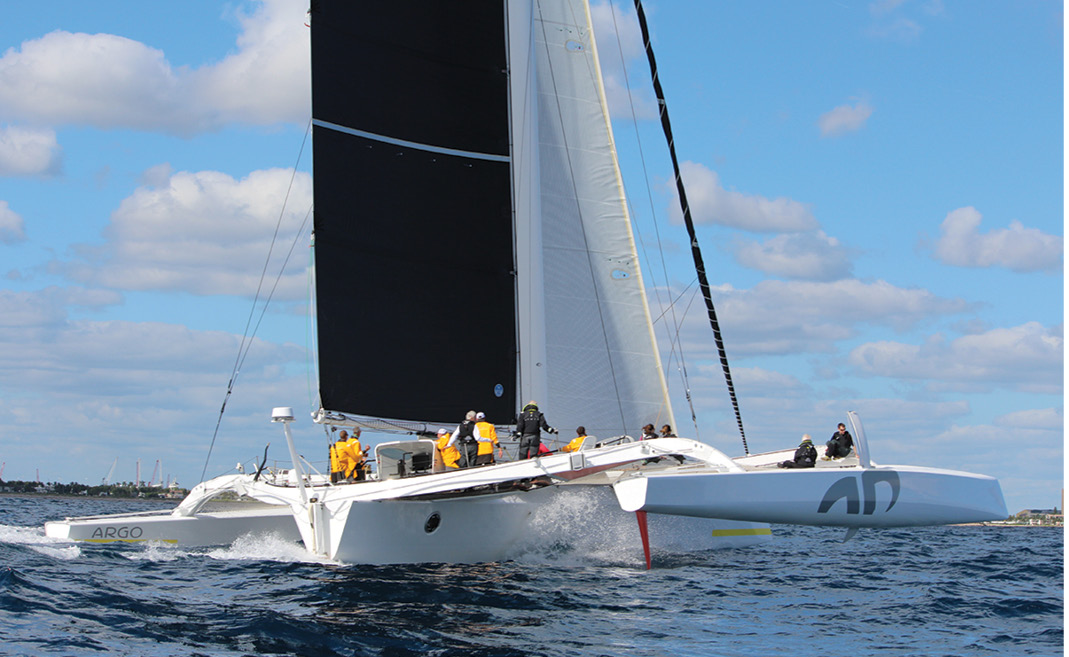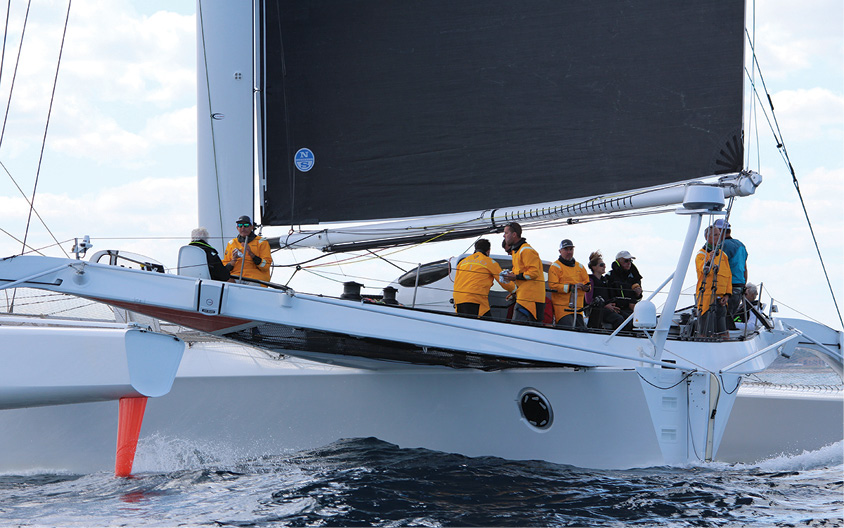By Ed Cesare
My longtime friend and shipmate Chad Corning recently invited me to come along on a delivery of Jason Carroll’s MOD 70 trimaran Argo from Newport, RI to Fort Lauderdale, FL. Readers might be familiar with Jason’s program and stable of race boats, including the turboed Gunboat 62 Elvis. Jason purchased the ex-Oman Racing last summer.

Jason Carroll’s MOD 7O trimaran Argo claimed line honors in the 62nd Wirth M. Munroe Ocean Race, completing the 60-mile course from Miami to Palm Beach in just over 3 hours, averaging nearly 20 knots and smashing the overall elapsed time record. © Gus Carlson
The MOD (“Multi One Design”) 70 was conceived in 2009 as a class of one-design transoceanic racers. These are the highest performance boats that race in the open ocean save the fabled Ultimes – 100-foot-plus trimarans that chase round-the-world records. In a decade of shredding the seas, MOD 70s have proven very reliable and VERY fast. I race regularly on some pretty high performance monohulls and have done some racing on the big “luxury” racing cats in the 60-foot range, but I knew I was in for something different.
Ubering up to Newport Shipyard, I dropped my gear by the container (more on that below) and found Chad and the other delivery crew including regular navigator Andersen Reggio, and three or four support folks, aboard the boat. The complexity of simply delivering, let alone racing, one of these machines is stunning. After a number of weeks of prep since smashing the elapsed time record for the 238-mile Vineyard Race in 14 hours, 58 minutes and 19 seconds, this accomplished group of professionals was flat out with final preparations for the delivery.
I’d brought most of my own kit including an offshore dry seal spray top (important), but Chad took me to the team container to collect other bits, including personal AIS locater and PLB. The container would remind one of something at NASA – pretty cool.
After another hour of prep we got off the dock. This is no small feat in even a light breeze, but with the help of the team RIB and a well thought out and coordinated plan we were underway and heading out of Newport Harbor. Once clear of Fort Adams, Sailing Master Brian Thomson gathered us around for a somewhat familiar safety briefing: life raft and ditch bag location, MOB procedure, etc. As this was a delivery, Brian’s standing order was “the main hull stays in the water.” So, a clear signal that we’d be somewhat throttled back for the trip. Sailed in anger with a race crew of 10, Argo’s main hull regularly rises out of the water as she sails on a leeward ama and the lift created by the curved daggerboards. Well, “throttled back” is pretty fast.
We got truly underway about 1300 in a breeze that was predictably a little stronger (18-25 knots) and a little farther left (farther ahead) than forecast. Andersen’s guidance was to use this breeze to get as far south as possible in the first 24 hours to close on and cross a stationary front draped along latitude 34, just south of Cape Hatteras. So, off we went on a course of about 165 true under a reefed main and J2, the middle-sized of three jibs. We “got right into it” as the boys say with a true wind angle of about 65, regularly making 25 to 28 knots with water everywhere. The fire hosing one receives anywhere outside the small “pod” or cuddy on the main hull dictates helmets with plexi visors all around. Life below on these boats (and on deck for that matter) is very hard. With the subway car-like motion of a big multihull, trying to sleep at those speeds is extremely difficult to say the least.

With benign conditions on the Munroe Race, the crew was able keep the helmets and visors stowed. © Gus Carlson
With the stiff northwesterly and even keeping “the main hull in the water” by Thursday evening we were abeam of Hatteras, approximately 480 miles down range! An interesting note: I wondered why the boat was set up to navigate based on true rather than magnetic headings. I figured it out: speeds across oceans are so fast that it is inconvenient to keep up with changes in variation as one’s longitude changes so rapidly!
The weather strategy was working well as we just skirted a developing low-pressure system along that stationary front. Another amazing feature of this kind of sailing is that you are truly able to place the boat where you want it relative to synoptic weather features. Experiencing an abrupt wind change as you hurdle through a front is a really strange feeling in comparison to waiting impatiently for the forecast change to unfold. We literally sailed right around the developing low, watched it chase us for a bit and then simply outran it.
We slowed a bit in the middle third of the trip as we encountered relatively light headwinds south of the front. This gave me, as a novice, a chance to steer. There are a couple things quite different from steering a monohull. First, the best “tell” in driving a high performance monohull is angle of heel. In a tri like Argo, there is none! Secondly, the boat loves to go straight. So, you have to get used to modulating your course adjustments, using the compass a good deal more than in “regular” boats. The conditions were lighter but I had a bit of fun in, experiencing 16 to 22 knots of boat speed at a true wind angle of about 48 degrees. That’s an upwind VMG of 14 knots. It is a myth that these boats do not go upwind. In fact, their VMG upwind is probably better than down.
As we worked father south we tried to get more westing in to close with the fresh northerly breezes associated with the next system. Reaching those, we covered the last 500 miles into Lauderdale in about 30 hours! For much of this time we were able to get on to the gennaker; this for the first time in the middle of the night, again with water everywhere. The sea state was pretty benign but just hurtling along at 30-plus really gets your attention. It is important to tend the gennaker sheet in case the helmsman buries the bow, to avoid a pitchpole. As I said, the sea state was pretty benign and our cadre of helmsmen could not have been more talented. Nevertheless, it was a bit daunting.
I wound up with he gennaker sheet in my hand on the first hoist and mentioned to Brian Thompson, “Brian, I get the idea here, but any advice?” He replied, “Yeah mate, if you think you’re gonna die, ease it.” Noted! Brian’s standing order notwithstanding, it was fascinating to watch the good helmsmen hook into the building apparent wind as the boat accelerated. They can ride that angle and just keep building apparent and boat speed well into the 30s.
After a magical, star-filled third night at sea, running down between the Bahamas and the Gulf Stream, we made the final jibe into Lauderdale and had a very easy Gulf Stream crossing. Catching the 0200 (Saturday morning) opening of the 17th Street Bridge, we made it to the Bahia Mar Yachting Center in time for a couple hours of sleep before I jumped a plane back home.
This was just an amazing experience aboard an amazing boat. Many thanks to Jason for putting such a thoroughbred on the water here in the States, Chad for the invite, and my shipmates for putting up with a novice.
An avid offshore sailor, Ed Cesare serves as Navigator on Ron O’Hanley’s very successful Cookson 50 Privateer. He has campaigned his own Class40 in three Atlantic Cups, two Vineyard Races and the 2014 Newport Bermuda Race. He’s done sixteen Bermuda races, three Transatlantics, three Fastnets and two Sydney Hobarts.
Ed currently serves as Rear Commodore of the Storm Trysail Club and Event Chair of Block Island Race Week 2019. He’s Commodore of Norwalk Yacht Club, a Trustee of New York Yacht Club, and a member of the Royal Ocean Racing Club. He lives in Norwalk, CT with his wife Christine. They have one grown son, Nick, and a Chocolate Lab, Lucie.




